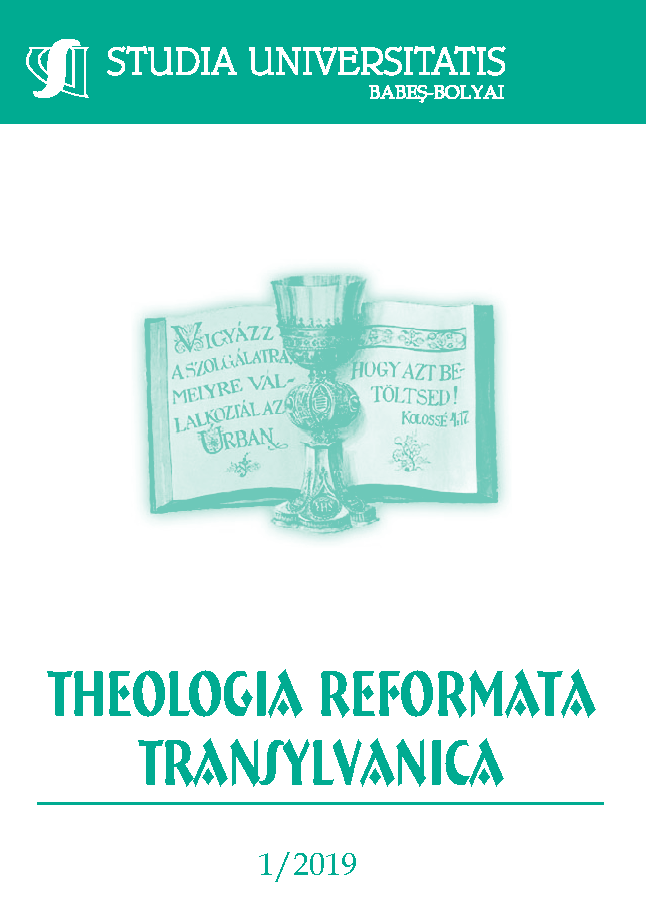A „nagy felsóhajtás zsoltára”. A Zsolt 124 magyarázata
DOI:
https://doi.org/10.24193/subbtref.64.1.12Keywords:
Bible, Old Testament, Psalms, Psalms of Pilgrimage, Chaos, Trap, Providence, Deliverance, ThanksgivingAbstract
The Psalm of the Great Sigh of Relief. Interpretation of Psalm 124.
The study examines Psalm 124, one of the greatest gems of the biblical psalm-poetry. After briefly expounding the metre, the genre and the poetic structure, the author dates the poem, analyzes the role of the Psalm in its immediate literary con-text, and provides linguistic, formal, tradition-historical and theological analysis passage by passage. The author regards the Psalm as one of the post-exilic impressions of the Zion theology along with the collection of Psalms 120–134 which was formed around 400 BCE. Regarding the form of the poem, it is masterfully structured. Traces of later adaptations and additions cannot be proven unequivocally. The theological specialties of the poem are the articulation of the preventive providence of God, the thanksgiving and the consistent trust toward the God of Israel. The Psalm fits in well with the collections of Psalms 123–125 and Psalms 123–130, where the preceding Psalm of lament continues with the themes of thanksgiving and teaching, and goes further toward the theme of salvation of the end times.
References
CALVIN, Johannes: Die Psalmen. 2. Haelfte (Johannes Calvins Auslegung der Heiligen Schrift 5/2). Kreis Moers, Neukichen, 1930.
DUHM, Bernhard: Die Psalmen (KHKzAT XIV). J. C. B. Mohr (Paul Siebeck), Tübingen, 1922.
GUNKEL, Hermann – BEGRICH, Joachim: Einleitung in die Psalmen. Die Gattungen der religiösen Lyrik Israels. Vandernhoeck & Ruprecht, Göttingen, 1933.
GUNKEL, Hermann: Die Psalmen. 5. Auflage, Vandernhoeck & Ruprecht, Göttingen, 1968.
HOSSFELD, Frank-Lothar – ZENGER, Erich: Psalmen 101–150 (HThK-AT). Herder, Freiburg – Basel – Wien, 2008.
KARASSZON Dezső: A Zsoltárok könyvének magyarázata. in: [szerk. nélkül:] Jubileumi kommentár. A Szentírás magyarázata. II. kötet, átdolgozott kiadás, Kálvin János Kiadó, Budapest, 1995, 541–640.
KEEL, Othmar: Die Welt der altorientalischen Bildsymbolik und das Alte Testament. Am Beispiel der Psalmen. 3. Auflage, Neukirchener Verlag, Neukirchen-Vluyn, 1980.
KITTEL, Rudolph: Die Psalmen (KzAT XIII). 5. u. 6. Auflage, A. Deichertsche Verlagsbuchhandlung D. Werner Scholl, Leipzig, 1929.
KRAUS, HANS-Joachim: Psalmen. 2. Teilband: Psalm 81–150 (BK XV/2). Neukirchener Verlag, Neukirchen, 1960.
KUSTÁR Zoltán: Ézsaiás próféta könyve. in: Pecsuk Ottó (szerk.): Bibliaismereti kézikönyv, Kálvin János Kiadó, Budapest, 2004, 243–271.
NÉMETH Áron: „Királyok zsoltára, zsoltárok királya”. A 72. zsoltár előállása és teológiája a zsoltárok könyve redakciójának tükrében. Exit Kiadó, Kolozsvár, 2018.
PETERSEN, Claus: Mythos im Alten Testament (BZAW 157). Walter de Gruyter, Berlin – New York, 1982.
RÓZSA Huba: Az Ószövetség keletkezése. Bevezetés az Ószövetség könyveinek irodalom- és hagyománytörténetébe. II. kötet. 2., átdolgozott kiadás, Szent István Társulat, Buda-pest, 1996.
SCHMIDT, Hans: Die Psalmen (HzAT I/15). J. C. B. Mohr Paul Siebeck, Tübingen, 1934.
SEYBOLD, Klaus: Die Wallfahrtspsalmen. Studien zur Entstehungsgeschichte von Psalm 120–134. Neukirchener Verlag, Neukirchen-Vluyn, 1978.
SEYBOLD, Klaus: Die Psalmen (HzAT I/15). J. C. B. Mohr (Paul Siebeck), Tübingen, 1996.
WEISER, Artur: Die Psalmen. Zweiter Teil: Psalm 61–150 (ATD 15). 9. Auflage, Vandernhoeck & Ruprecht, Göttingen, 1979.
WESTERMANN, Claus: Ausgewaehlte Psalmen. Göttingen, Vandernhoeck & Ruprecht, 1984.
WOLFF, Hans Walter: Az Ószövetség antropológiája [Eredeti megjelenés: Anthropologie des Alten Testaments, 6. Auflage, Chr. Kaiser – Gütersloher Verlagshaus, Gütersloh, 1994]. Harmat – PRTA, Budapest, 2001.
ZENGER, Erich: Psalmenauslegungen. Band 2: Ich will die Morgenröte wecken. Verlag Her-der im Briesgau, Briesgau – Baserl – Wien, 2003.
ZENGER, Erich: „Áldjon meg téged az Úr Sionból”. Megjegyzések a zarándokzsoltárok (Zsolt 120–134) teológiájához. 1. rész: Pannonhalmi Szemle. XVI. évf., 2008. 3. szám. 12–22; 2. rész: Pannonhalmi Szemle. XVI. évf., 2008. 4. szám. 19–40.
XERAVITS Géza: A Zarándokénekek. Zsoltártanulmányok, első kötet (Zsolt. 120–134) (Lectio divina 3). Szent Mauríciusz Monostor – L’Harmattan, Bakonybél – Budapest, 2006.
WOUDE, VAN DER, Adam Simon: šēm Name. in: Jenni, Ernst – Westermann, Claus (ed.): Theologisches Handwörterbuch zum Alten Testament. Band II. Chr. Kaiser Verlag – Theologischer Verlag, München – Zürich, 1976, 935–963.
Downloads
Published
How to Cite
Issue
Section
License
Copyright (c) 2019 Studia Universitatis Babeș-Bolyai Theologia Reformata Transylvanica

This work is licensed under a Creative Commons Attribution-NonCommercial-NoDerivatives 4.0 International License.



